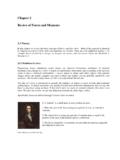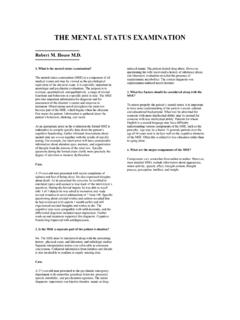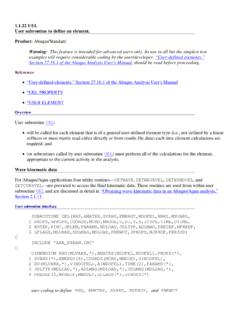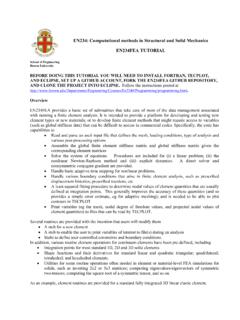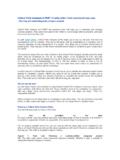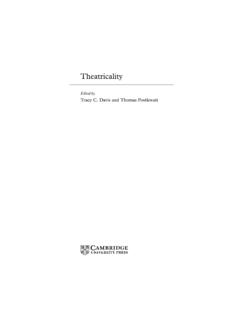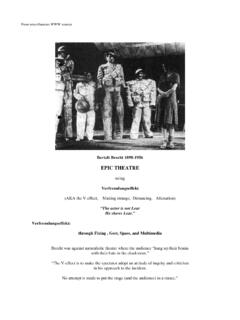Transcription of The Resistance to Theatricality Author(s): Marvin Carlson ...
1 The Resistance to TheatricalityAuthor(s): Marvin CarlsonSource: SubStance, Vol. 31, No. 2/3, Issue 98/99: Special Issue: Theatricality (2002), pp. 238-250 Published by: University of Wisconsin PressStable URL: : 29/01/2009 21:43 Your use of the JSTOR archive indicates your acceptance of JSTOR's Terms and Conditions of Use, available JSTOR's Terms and Conditions of Use provides, in part, that unlessyou have obtained prior permission, you may not download an entire issue of a journal or multiple copies of articles, and youmay use content in the JSTOR archive only for your personal, non-commercial contact the publisher regarding any further use of this work.
2 Publisher contact information may be obtained copy of any part of a JSTOR transmission must contain the same copyright notice that appears on the screen or printedpage of such is a not-for-profit organization founded in 1995 to build trusted digital archives for scholarship. We work with thescholarly community to preserve their work and the materials they rely upon, and to build a common research platform thatpromotes the discovery and use of these resources. For more information about JSTOR, please contact of Wisconsin Press is collaborating with JSTOR to digitize, preserve and extend access Resistance to Theatricality Marvin Carlson Probably the most distinctive feature of theoretical speculation concerning the theater during the past twenty years has been the cross- fertilization of this field of study with the social sciences.
3 While traditionally theater theorists have most commonly looked to the work of literary theorists or philosophers for inspiration, concepts, and analytic strategies, today they are much more likely to look to such cultural analysts as anthropologists, ethnographers, psychologists and sociologists. The changes in the investigative fields of both theater and the social sciences as a result of this shift have been enormous-indeed the fields themselves have been significantly reconfigured. Perhaps the most familiar example of this cross- fertilization was the converging interests of anthropologist Victor Turner and theater theorist Richard Schechner, but scarcely less important have been the theatrical metaphors in the influential writings of sociologist Erving Goffman, and the emphasis on the performative aspects of language by linguists John Austin and John Searle.
4 In each of the fields represented by these theorists, their work and the work of others who have been influenced by their approaches have radically altered both critical approaches and critical vocabulary. So widespread and so productive has been this interpenetration of the formerly fairly discrete fields of theater studies and the social sciences that it is hardly an exaggeration to say that in the study of social phenomena today metaphors of theater and performance are so common that they have become almost transparent, while conversely, in the study of theater, a similar critical dominance is currently held by the metaphors and the topoi of social analysis.
5 Useful and productive as this cross-fertilization has been, it has not been without cost, for of course any new interpretative grid, any new critical paradigm, inevitably brings some distortion along with its clarifications, and when the clarifications have been as stimulating and productive as those resulting from the growing convergence of the analytical methodologies of theater and performance studies and of the social sciences, then the distortions involved are very likely to be overlooked in the general enthusiasm over important new insights.
6 238 ? Board of Regents, University of Wisconsin System, 2002 SubStance # 98/99, Vol. 31, nos. 2 & 3, 2002 239 Thanks to the widespread influence of such theorists as Turner, Schechner, Goffman, Austin, and the many subsequent theorists who have since the 1960s worked in these converging fields, it has become almost impossible to consider the term performance, in the many ways that it is used in contemporary critical writings, without the term being conditioned to a greater or lesser extent by the implications of its use as a key critical term in current work in the social sciences.
7 This new orientation of the term performance has hardly gone unremarked. Indeed it has been celebrated and in fact institutionalized, in large part due to the efforts of Richard Schechner. As early as 1973 Schechner in a special issue of The Drama Review called for more study of the "areas where performance theory and the social sciences coincide" (5). Since that time Schechner has devoted much of his career to this study in an influential series of books and articles, and he was instrumental in the establishment of a department of performance studies at New York University.
8 The high visibility of the term "performance" in recent writings about theater, and its acknowledged relationship to theories and concerns in the social sciences, has obscured the fact that theater theory in general has become more involved in recent years with concepts and strategies related to the social sciences. This affects the way the field is evolving and how its terms are configured, even when the perhaps overdetermined rubric of performance seems not to be directly involved. A striking example of this may be seen in recent uses of the term Theatricality , which, like performance, has been very differently configured as a result of the interpenetration of theatrical and social science theory, but which has not gained, as performance has, a higher visibility and a generally more productive and flexible critical usage as a result.
9 On the contrary, I would argue, Theatricality has been reduced and constricted as a working term by this process. Indeed, in some cases its decline can, I think, be almost directly correlated to the relative success of performance, where the two have been posited as rhetorically oppositional terms. A key work in locating the term Theatricality within the developing interface of theater and the social sciences was the book by that name published by Elizabeth Burns in 1972. Bums and her husband were pioneers in the modern application of sociological methodology to literary and theatrical studies, and Burns herself described the book Theatricality as an attempt to bring together material from three hitherto separate fields- the history of drama and theater (represented by such scholars as Allardyce Nicoll and Glynne Wickham), the Chicago School of sociology (whose best SubStance # 98/99, Vol.)
10 31, nos. 2 & 3, 2002 The Resistance to Theatricality 240 Marvin Carison known exponent was Erving Goffman), and the European, largely French tradition of sociology of the theater, founded by Jean Duvignaud. Burns, anticipating in some measure the insights of Judith Butler concerning the "performative" in social life, suggests that theater is a vehicle for the "transmission of specific beliefs, attitudes, and feelings in terms of organized social behavior." " Theatricality ," occurs when certain behavior seems to be not natural or spontaneous but "composed according to this grammar of rhetorical and authenticating conventions" in order to achieve some particular effect on its viewers (33).
